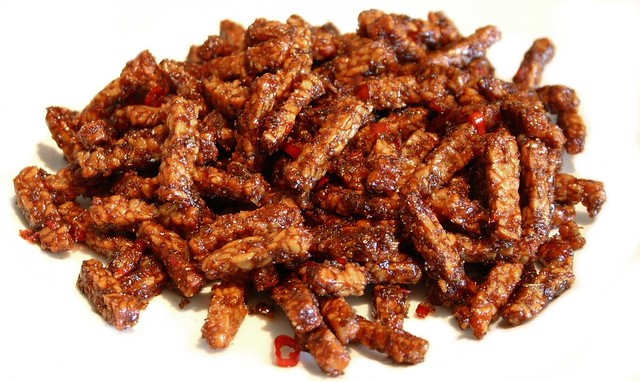I’ve always loved barbecueing, the taste of roasted meat with the smokey flavour of the charcoal, I just love it. Unfortunately, living in the city for the past 20 years, means I hardly ever barbecue. Not even once a year. Poor me. But fortunately, thanks to two discoveries in the last years I don’t miss it anymore! First I discovered the griddle pan (grillpan in dutch) and then a few years later I discovered the stovetop smoker (rookoventje in dutch).
Smoker & smoking agents

First you need a seperate kitchen and a ventilation hood. If you don’t have those you need to do this outside on a portable stove because you will smell this for a day or so.
Then how does it work? It’s simple. You’ve got this container. You add 1 or 2 tablespoons of “smoking agent” (normally wood chips). On top of that you put this drip tray and a roasting rack. Put the oiled meat, fish or vegetable on the tray, close the lid, put on a stove with the gas just 2 mm higher than low. Don’t forget to on turn your ventilation hood! When you see smoke escaping from the edges turn the gas down to minimum. Normally you only need to smoke it for about 7 minutes, patdry and grill in a griddle pan. The trick is to just smoke it enough to get the right smokey flavour, without getting a bitter, burned taste or overcooking your the meat you want rare.
alder => Nutty & heavy. Use for: meat and tofu
apple => Light, fruity & nutty. Use for: white fish
cherry => Light & fruity. Use for: fish, chicken or vegetables
hickory => Light, not very smoky. Use for: wild poultry like pheasant
maple => Woody & tabacco-ish. Use for: shrimp and lobster
mesquite => Heavy. Use for: spareribs
oak => Spicy. Use for: salmon
pecan => Nutty, coco, coffee-ish. Use for long smoking.
rice, black tea, sugar mixture => use for: duckbreasts
earl grey tea => Use for: scallops
Tip of the day: go to your fishing gear shop. They sell bags full of cheaper woodchips. And cheaper smokers too!
= = = = = = = = = = = = = = = = = = = = = = = = = = = = = =
Steak and other red meat

You can marinate your meat or just smoke it au naturel. You don’t even have to take it out of the fridge to get it to roomtemperature, the smoking will do that for you. Just make sure you pat dry and oil it. Without the oil it might dry out. Tip of the day: when the steaks you buy in your supermarket turn out to be ridiculously and unevenly shaped, sometimes it helps to put a string around them. Like the ones in the photo above, they were rubbish, but a string made them nice and even. But other times, even a string won’t help.
Anyway, smoke it for about 7 minutes, not much more, you don’t want it to be cooked. Take it out of the smoker or better yet, turn off the gas and leave it for another few minutes until you’re ready to grill it. Pat dry, oil it again, salt it and grill it for just 1 minute each side max. Let it rest a few minutes on a warm plate with tin foil before you serve/cut it.
I used to eat my steaks rarer than rare, but with smoking that’s in the past. Fortunately, it’s still succulent and moist, it tastes better than just panfrying it medium. Probably because it’s a bit like slowcooking at low temperature.
The best cuts for smoking are the ones with some fat, like entrecote/sirloin and of course duckbreast! I love smoking duckbreast.

= = = = = = = = = = = = = = = = = = = = = = = = = = = = = =
Smoking Fish

With fish you can go three ways.
- Smoke it like meat just for the flavour and finish it in a (griddle) pan.
- Smoke it for 20 minutes or more until cooked.
(Like on photo above, recipe here : salmon in maple syrup
or smoked trout used in this lovely potato salad)
- First brine the fish, then smoke it until cooked.
(Like on photo below, recipe here: smoked mackerel pate)

= = = = = = = = = = = = = = = = = = = = = = = = = = = = = =
Smoking vegetables & other stuff

Officially vegetables need to be blanched first, but I don’t always bother. With bell peppers I don’t think it’s necessary. I smoke them for 20 minutes before using them in regular recipes, like the soup on the photo above. (smoke 4 red bell peppers and 10 cloves of garlic, then whizz them with some vegetable stock and a boiled potato)
You can smoke peeled tomatoes for a smokey tomato-sauce. I’ve smoked paprika (the powder) once when I needed smoked Spanish paprika and didn’t have any, it was almost like the real thing! You can smoke cheese. I even saw a chef smoking a cup of milk that he later used for making mashed potatoes! I still need to try that trick. Anyway, the sky is the limit with smoking.
One of my best used cookbooks ever is this little book with recipes for your smoker. Unfortunately for all the english readers, it’s dutch/belgium: Gerookte lekkernijen van Cecile Thijssen. But I can really recommend this book. Everything you need to know about hot smoking is in there with loads of simple recipes.

























































